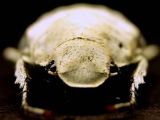Scientists have started looking to nature in order to develop better designs and materials, like adhesives based on geckos' foot pads, coating surfaces imitating shark skin to easy-clean surfaces inspired by lotus leaves.
Now, they have found a new model. It looks like a ghost beetle. Or like being covered by an extremely white mold. But the amazing color of the ghost beetle is given by its super-thin, paper-white pattern of its minute scales.
"The long, flat overlapping scales that cover the head, body and legs of the white Cyphochilus beetle, a common sugarcane pest in Southeast Asia, are brighter than milk, pearly teeth or most other white substances found in nature", says Pete Vukusic, an optical physicist at Exeter University in England.
The scales are extremely tiny, about half the width of a red blood cell, at least 100 times thinner than any whitening and brightening compound discovered as yet. "And they could inspire advances that improve the paper we write on, the color of our teeth and possibly the brightness of lights and displays in the future," Vukusic said.
For some time, insect wings have warned the watchful eye of the scientists looking on color manipulation and color-flow structures that nature developed, "since it surely must have come up with some really good ideas. We know structural color in butterflies dates back at least 50 million years," said Vukusic.
Most animals get their color and color pattern from pigments that absorb some wavelengths of light and reflect others, but in insects pigments do not make all the work: some colors, shades and brightness come from minute structures that make wavelengths of light interact with each other, changing absorption/reflection.
The same happens with soap bubbles and glossy bird feathers (like in the case of the peacock).
White is a very rare color in nature, more common maybe in polar zones, because creatures try to hide themselves in the environment. "White backgrounds are not generally found in, say, savannahs," Vukusic said.
Scientists suspect the beetle imitates local white fungi. The white color means that a substance has to reflect all colors of light randomly at the same time.
Electronic microscopes revealed that the scales of the Cyphochilus beetle have structures made of randomly oriented filaments, whose size and spaces between them are balanced by the scales.
The structures reflect light far more easily than any known compound, generating a brilliant white even when very thin (the actual thickness is 5 microns, five millionths of a meter). "Future research could help devise extraordinarily bright white synthetic materials. These could, for instance, help reflect light, replacing the bulky glass mirrors at times found in flat-panel displays," Vukusic said.
Photo credit: P. Vukusic / University of Exeter

 14 DAY TRIAL //
14 DAY TRIAL // 
